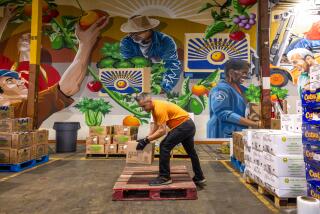Organization Gets Unwanted Food to the Hungry
- Share via
CHICAGO — When a manufacturer was saddled with 37 railroad cars full of cereal that contained too many raisins, Second Harvest was glad to take it off the company’s hands.
When 5 million pounds of grapefruit juice could not be sold because it was not yellow enough, the Chicago-based organization found a demand.
And when 600,000 pounds of bananas had not ripened by the time they were to be delivered to a retailer, the nonprofit group took them, too.
Second Harvest is making sure that $300 million worth of edible food that might otherwise have been dumped will be distributed to the hungry this year.
“We work with local food banks to try to get food to the 20 million people in this country who suffer from some form of hunger,” Philip Warth, the group’s director said.
This year, Second Harvest expects to distribute about 100 million pounds of food products with a market value of $300 million through food banks in 46 states and more than 16,000 charitable organizations.
It deals with big companies like Beatrice, Pillsbury and General Mills, acting as a distributor of products that may not be marketable due to dented cans or damaged boxes but are edible, Warth said.
In the case of the cereal with too many raisins, Warth said the manufacturer did not want the public to expect that many raisins and so did not want the product on the open market.
“We have the warehouse space, and we can approach the donor with some assurance that the product will be handled in a fashion that protects its integrity,” Warth said.
About 40% of Second Harvest’s operating revenue comes from member food banks. Corporations and foundations provide the rest.
More to Read
Eat your way across L.A.
Get our weekly Tasting Notes newsletter for reviews, news and more.
You may occasionally receive promotional content from the Los Angeles Times.










